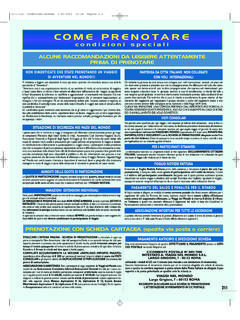Transcription of Ventilation for buildings — Calculation of room ...
1 Document type: European Standard Document subtype: Document stage: Formal Vote Document language: E J:\Intcom\CEN\CEN 156\ pren 15243\ STD Version CEN/TC 156 Date: 2006-07 pren 15243 CEN/TC 156 Secretariat: BSI Ventilation for buildings Calculation of room temperatures and of load and energy for buildings with room conditioning systems L ftung von Geb uden Berechnung der Raumtemperaturen und der Last und Energie f r Geb ude mit Systemen zur Raumkonditionierung Ventilation des B timents Calculation des temp ratures des locaux et des charges et nergies pour les b timents avec des syst mes de conditionnement des locaux ICS: Descriptors: pren 15243:2005 (E) 2 Contents Page 1 8 2 Normative references .. 9 3 Terms and 11 4 Symbols and abbreviations .. 13 5 General 15 6 Room temperature Calculation without room conditioning system .. 17 Choice of 17 Calculation 17 Boundary conditions.
2 17 Climatic Data .. 17 Internal 17 Window opening .. 17 Acceptable comfort conditions .. 17 7 Room cooling load Calculation .. 17 Basic sensible room cooling load Calculation .. 17 System dependent sensible room cooling load Calculation .. 17 Latent room cooling load Calculation .. 18 Boundary conditions .. 18 Definition of room conditions (temperature, humidity, tolerances) .. 18 Climatic data .. 18 Internal loads .. 18 Ventilation rates .. 18 8 Room heating load Calculation .. 18 Calculation procedure .. 18 Climatic data .. 18 Ventilation rates .. 18 9 Room based equipment sizing .. 19 10 Zone load Calculation .. 19 11 System heating and cooling load Calculation .. 19 12 Central system equipment sizing .. 19 13 Room and building energy 19 General .. 19 Humidification and dehumidification energy demand .. 19 Relation to system energy Calculation methods.
3 20 14 System Energy 21 General 21 System structure and boundaries .. 21 Energy Calculation structure .. 21 Calculation 24 HVAC System Overview .. 25 Required functionality of detailed and simplified Calculation 27 General Principles and Reporting of 27 Verification of building and HVAC system Calculation methods .. 28 Calculation Procedures: Information in other standards .. 38 Simplified system losses and energy demand Calculation methods .. 39 General 39 Emission losses .. 39 pren 15243:2005 (E) 3 Emission auxiliary energy demand Calculation .. 40 Calculation of Cold Water Distribution .. 40 Humidification and dehumidification energy demand .. 40 Cold Generation and Chiller Energy Performance .. 40 Example Calculation procedures .. 40 Detailed system losses and energy demand Calculation method .. 40 General 40 Climatic Data .. 40 Annex A (informative) Best procedure for design 41 Annex B (informative) Proposed procedure for choice or typical rooms for temperature Calculation .
4 43 Annex C (informative) System overview .. 44 Annex D (informative) Schematic relationship between HVAC system energy procedure, building energy demand calculations, data and outputs .. 51 Annex E (informative) Example simplified system losses and energy demand Calculation methods .. 60 Example 1 (Dutch proposal) .. 60 Emission losses .. 60 Distribution 60 Storage 64 Generation efficiency and energy consumption .. 64 HVAC system annual energy consumption .. 66 Example 2 (German proposal) .. 67 67 Application for the territory of federal republic of Germany .. 68 Specific guide 73 Energy demand for air transport .. 80 Conversion an Calculation of specific values .. 80 Example .. 84 Example 3: Monthly HVAC System Cooling Energy calculations using degree-day methods .. 86 Theory .. 86 Worked 90 Annex F (informative) EDR Verification of building and installation Calculation 94 Introduction.
5 94 Brief description of 94 How to obtain the attest (quality certificate) .. 96 Importance of EDR .. 97 Relations: EDR, CEN, ISO, IEA HVAC BESTEST etc.. 97 Method description .. 97 Functionality Matrix .. 99 Masks .. 99 Reference/Test cases .. 99 Results of reference cases should fall within certain ranges .. 99 Example of the Functionality Matrix .. 99 Example: Mask generation of 104 EDR Calculation method for reference 105 Introduction .. 105 Centre of the reference area .. 105 Structure of the reference 105 Size of the reference area (bandwidth) .. 105 Examples .. 106 Annex G (informative) Example values for emission 107 Zones including several 107 Control 107 Annex H (informative) Calculation of latent energy demand .. 109 pren 15243:2005 (E) 4 Presentation .. 109 Application for hourly Calculation .. 110 Annex I (Informative) Example Calculation of Seasonal Efficiency of Cold Generators and Chillers in Air Conditioning 113 Introduction.
6 113 Theory .. 113 The 113 Combination of Load Frequencies and Part-load Performance Measurements .. 114 Seasonal performance indices .. 115 Calculation of Representative EIRs .. 115 Multiple Chillers .. 115 For systems with multiple chillers, a combined EIR value must be calculated for each bin, representing a combined EIR of all the operating chillers (and the load conditions on each for example, one chiller at full output and a second one at 50% of full output). Note that this is not obtained by averaging EERs (unless the harmonic average is used) but by adding consumptions and determining the combined total consumption. The later worked example illustrates 115 Calculations for 115 Practical 116 Background .. 116 Ideally the theory would be applied to data that are specific to the building and system under consideration, to the actual or expected pattern of use, and to the local climate.
7 This requires detailed information on chiller performance over a wide range of conditions, and detailed estimates of building cooling demand from detailed simulation, for example. Such detailed information is rarely available, and simplifications have to be made. This section describes how this may be done in ways that are consistent with various levels of available data.. 116 Simplification of Load Frequency Data .. 117 Approximation of Chiller Performance Data .. 118 Illustrative Example of Estimation of Seasonal 120 Load frequency distributions .. 120 Combined chiller performance .. 121 Mapping the chiller ratings on to the load frequency .. 122 Example for calculated Part-Load-Values .. 124 Annex J (Informative) Auxiliary energy for cooling-water and cold-water distribution .. 129 Electrical energy demand .. 129 Electrical energy demand of distribution .. 131 Hydraulic energy demand for distribution.
8 132 Pressure head at the design-rating operating point .. 133 p approximation 134 Pump operating times .. 135 Mean distribution 136 Correction factor fAbgl for hydraulic adjustment .. 137 Demand coefficients .. 138 Efficiency factor fe of the pump .. 138 Correction factor fAdap for adaptation: .. 139 Pump power adaptation during 139 Switching of individual pumps in parallel-pump installations .. 140 Other auxiliary energy demands (auxiliary drives) .. 140 Pump heating registers .. 140 Pumps and drives for heat 140 Water humidifier pumps .. 141 Electrical energy demand for central HVAC unit 142 Guideline for calculating the electrical energy demand of cooling-water and cold-water distribution systems .. 142 General .. 142 Specific volume flow in the distribution circuit .. 143 Pressure head pZ at the design-rating operating 143 Annual pump operating times ld, 144 pren 15243:2005 (E) 5 Specific electrical power of 144 Electrical energy demand of distribution.
9 144 Annex K (Informative) Thermal and dehumidification distribution losses in cooling systems .. 146 Cooling for the HVAC system .. 146 Cooling energy supply for space cooling .. 147 Annex L (Informative) Auxiliary energy use by terminals .. 149 Energy demand for space cooling 149 Annex M (informative) Auxiliary energy demand, heat 150 Calculation .. 150 Partial-load index values of heat rejection 153 Annex N : Bibliography .. 155 pren 15243:2005 (E) 6 Foreword This document pren 15243 has been prepared by Technical Committee CEN/TC 156 Ventilation for buildings , the secretariat of which is held by BSI. This document is currently submitted to the Formal Vote. This document has been prepared under a mandate given to CEN by the European Commission and the European Free Trade Association, and supports essential requirements of EU Directive 2002\91\EC.
10 pren 15243:2005 (E) 7 Introduction Chapters 13 and 14 of this standard deal with the Calculation of the energy demand of HVAC systems, specifically in connection with the Energy Performance Rating in connection with the Energy Performance of buildings Directive. The Calculation of the building energy demand that has to be met is dealt with in pren ISO 13790:2005 "Thermal Performance of buildings Calculation of energy use for space heating and cooling" this information is input data for the procedures addressed in this standard. Calculation methods satisfying this standard may also be used for other purposes, (for example, for system sizing). These are covered by chapters 1 to 12 of the standard. Users of Calculation methods should exercise care in ensuring that the need for appropriate modifications are considered and, if necessary, implemented for other applications.














